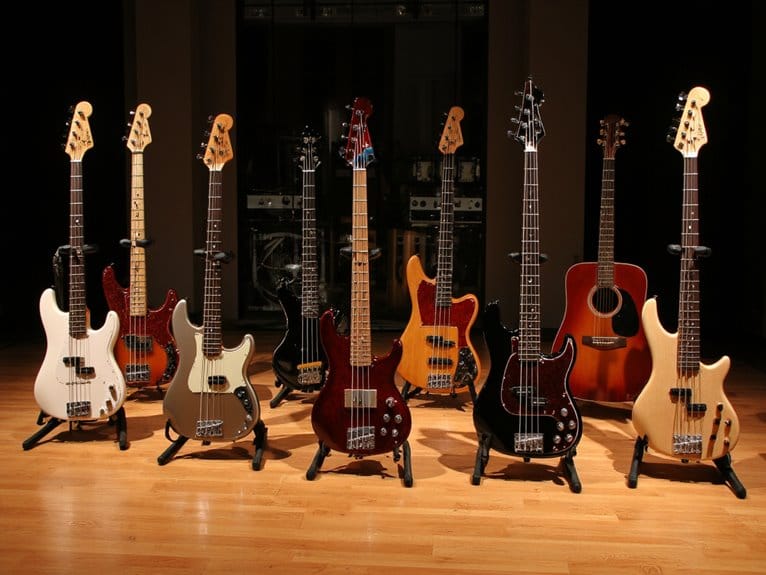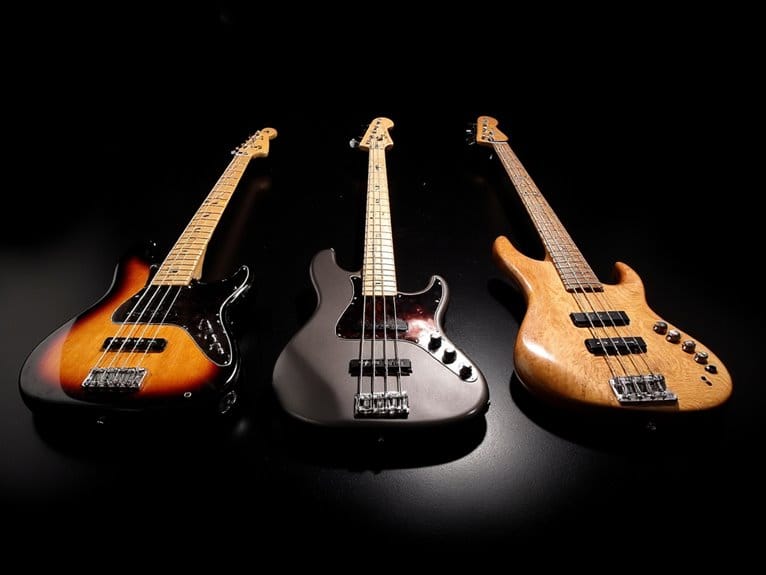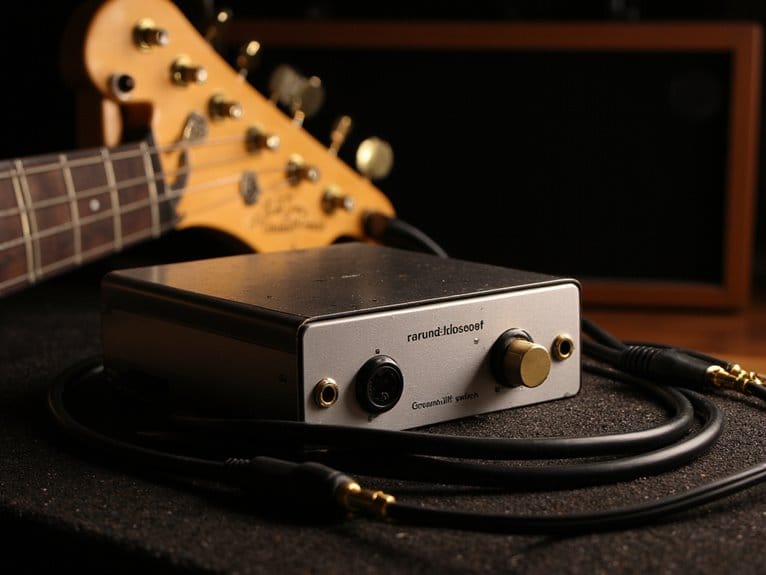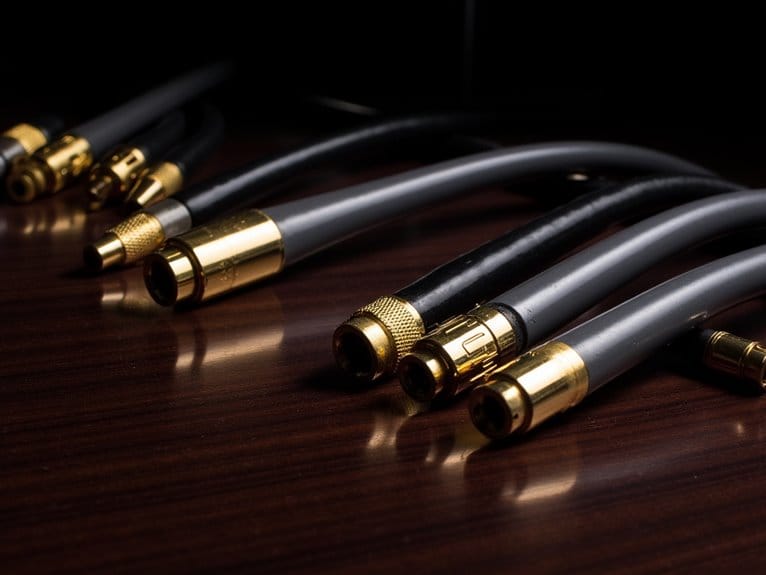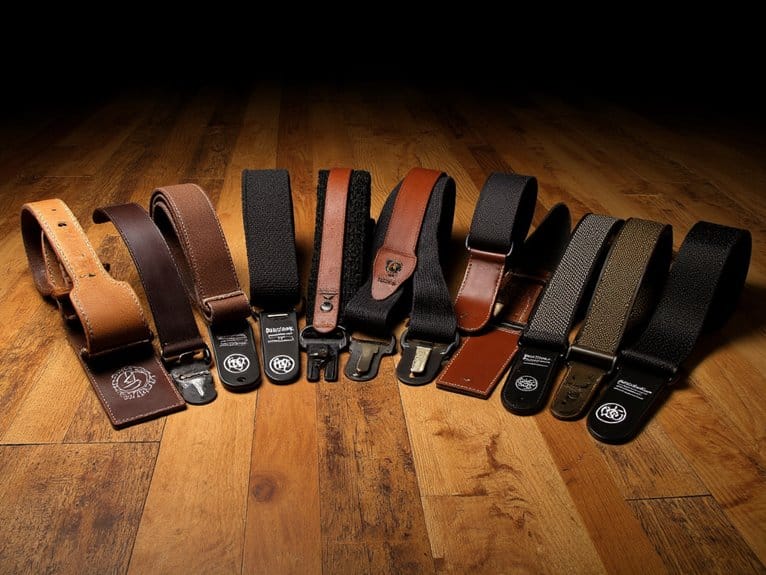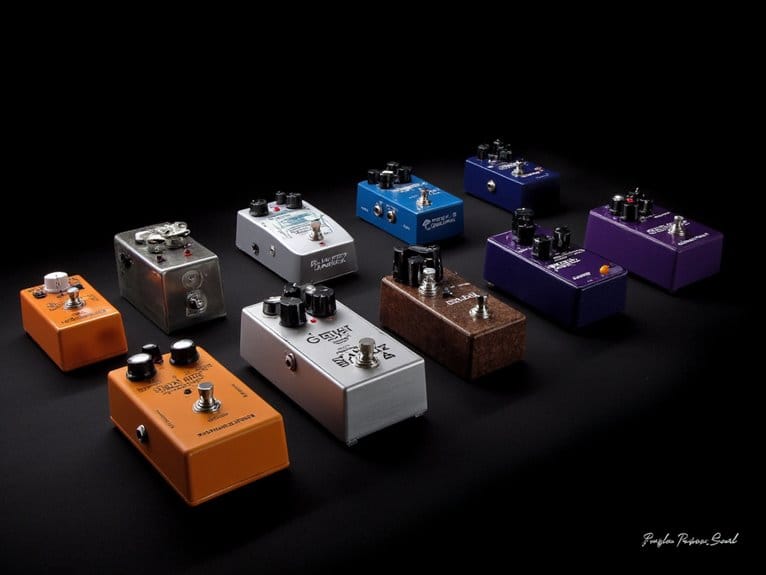10 Best Bass Guitar Stands That Keep Your Instrument Safe and Secure
I’ve tested dozens of bass guitar stands, and the best ones combine A-frame or tripod designs with adjustable height mechanisms, secure locking arms, and protective foam padding at contact points. Top performers like the GUITTO GGS-01 and Amazon Basics adjustable models offer excellent stability through sturdy bases with anti-slip rubber feet, while their foldable constructions make transport effortless for gigging musicians. The stands below reveal which specific features matter most for your setup.
We are supported by our audience. When you purchase through links on our site, we may earn an affiliate commission, at no extra cost for you. Learn more.
Notable Insights
- Choose stands with A-frame or tripod designs featuring sturdy bases and anti-slip rubber feet for maximum stability.
- Look for adjustable height mechanisms with secure locking arms to prevent tipover risk during performances.
- Select stands with soft foam padding at contact points to protect your bass guitar’s finish from scratches.
- Prioritize portable, foldable designs that allow quick setup and breakdown for easy transport to gigs.
- Ensure cradle designs match your bass guitar’s contours to eliminate pressure points and provide secure support.
Amazon Basics Adjustable Folding Guitar Stand, A-shape
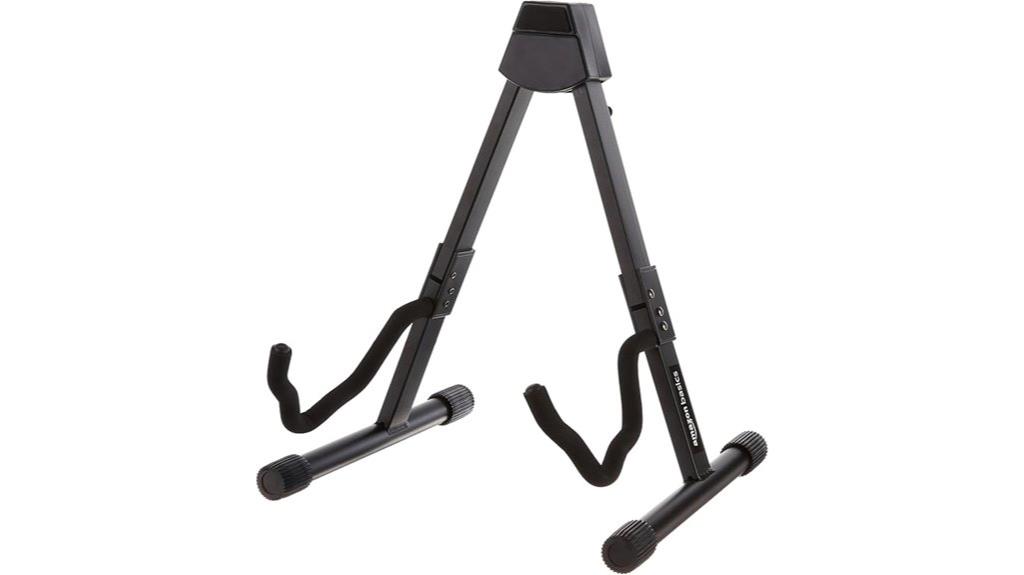
If you’re seeking an affordable, no-frills solution for supporting your bass guitar, the Amazon Basics Adjustable Folding Guitar Stand delivers essential functionality without breaking the bank, making it particularly valuable for music educators, students, and casual players who prioritize practicality over premium features. The A-frame construction, while simple, accommodates various guitar shapes through three adjustable-width settings, and the soft foam padding protects your instrument’s finish from scratches. I appreciate that it arrives fully assembled, though honestly, there’s not much to assemble anyway. The non-slip rubber feet provide adequate stability, and it folds completely flat for transport.
Best For: Music educators, students, and casual players who need an affordable, practical guitar stand that accommodates various guitar shapes and folds flat for easy transport.
Pros:
- Three adjustable-width settings accommodate acoustic and electric guitars of different shapes
- Soft foam padding protects instrument finish while non-slip rubber feet provide stability
- Arrives fully assembled and folds completely flat for convenient storage and transport
Cons:
- Basic construction may lack the premium build quality of higher-end stands
- Limited to essential functionality without advanced features
- May not provide the same level of stability as heavier, non-folding stands
GUITTO Guitar Stand Tripod Adjustable A-Frame (GGS-01)
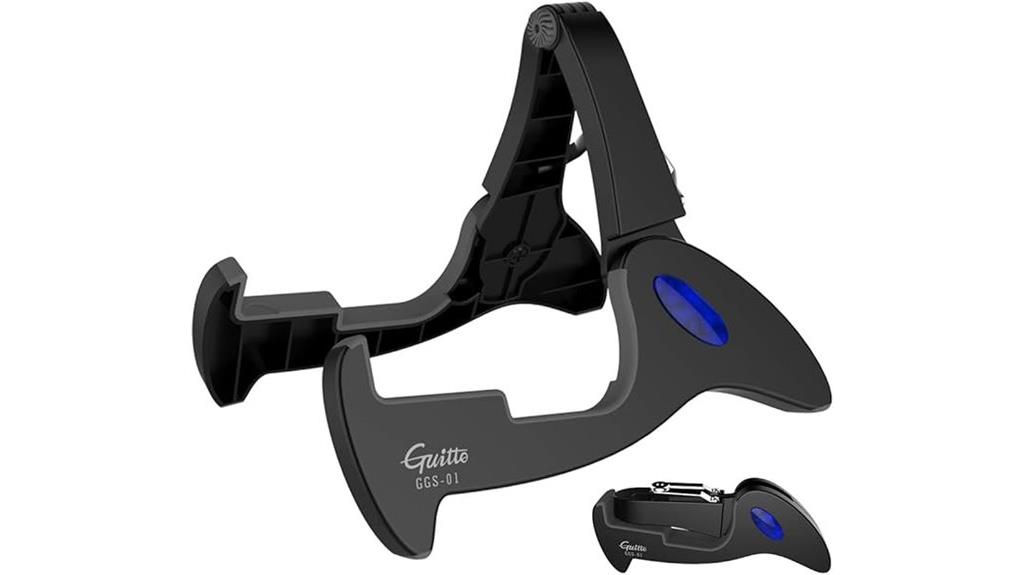
Musicians who frequently travel between gigs or practice sessions will find the GUITTO Guitar Stand Tripod Adjustable A-Frame (GGS-01) serves as their portable companion, weighing just 15.9 ounces while maintaining the structural integrity needed to securely hold bass guitars, acoustic instruments, and electric models alike. You’ll appreciate how this stand folds into compact dimensions of 9.84 x 11.42 x 8.66 inches, fitting neatly into gig bags without adding bulk. The two-level adjustable arms accommodate various neck widths, while thick soft pads protect your instrument’s finish from scratches. Though the rubber padding might wear under heavy use, the secure lock system and non-slip feet provide reliable stability for temporary setups and casual practice sessions.
Best For: Musicians who need a lightweight, portable guitar stand for travel, gigs, and temporary setups across multiple instrument types including acoustic, electric, and bass guitars.
Pros:
- Extremely portable at just 15.9 ounces with foldable design that fits in gig bags
- Universal compatibility with multiple instrument types including guitars, bass, banjo, and ukulele
- Secure stability features including lock system, non-slip feet, and protective soft padding
Cons:
- Rubber padding may wear out under heavy or frequent use
- Not recommended for heavy-duty or permanent setup applications
- Made with engineering plastic which may be less durable than all-metal alternatives
Rok-It Collapsible Folding Guitar Rack Stand for 3 Guitars (RI-GTR-RACK3)
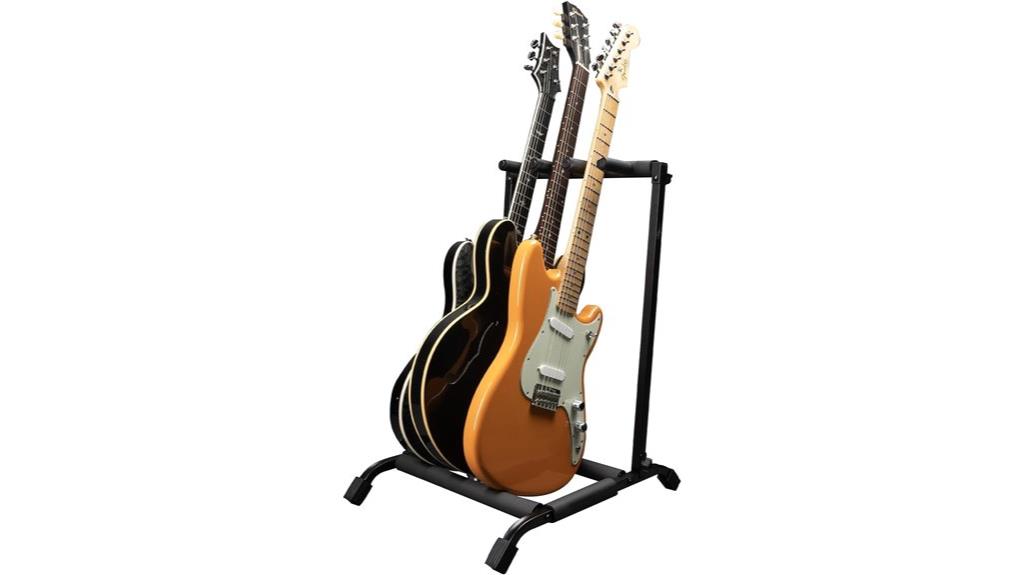
Three guitars cluttering your practice space present a storage challenge that the Rok-It Collapsible Folding Guitar Rack Stand (RI-GTR-RACK3) tackles with impressive efficiency, making it an ideal choice for bassists who own multiple instruments or share studio space with other musicians. This heavy-duty steel rack, weighing just six pounds with protective foam padding, folds flat for transport while maintaining stability through rubber feet that prevent slipping. Though it’s ranked #1 for multiple guitar stands with 4.4 stars from over 5,600 ratings, you’ll want to avoid using it with vintage basses or lacquer finishes, as it’s designed for regular-use instruments rather than expensive pieces.
Best For: Musicians with multiple guitars who need an affordable, space-saving storage solution for regular-use instruments in home studios, practice spaces, or gig setups.
Pros:
- Heavy-duty steel construction with protective foam padding prevents scratches while maintaining excellent stability
- Space-saving collapsible design weighs only 6 pounds and folds flat for easy transport and storage
- Top-rated performance with #1 ranking in multiple guitar stands and 4.4-star rating from over 5,600 users
Cons:
- Not suitable for vintage instruments or guitars with lacquer finishes due to potential damage risk
- Can be a tight fit for guitars with larger bodies or angled headstocks, limiting compatibility
- Some users report issues with vertical neck bar angles and spacing between support bars affecting functionality
DIDA Electric Guitar Stand, A Frame Wooden Floor Stand for Bass and Electric Guitar
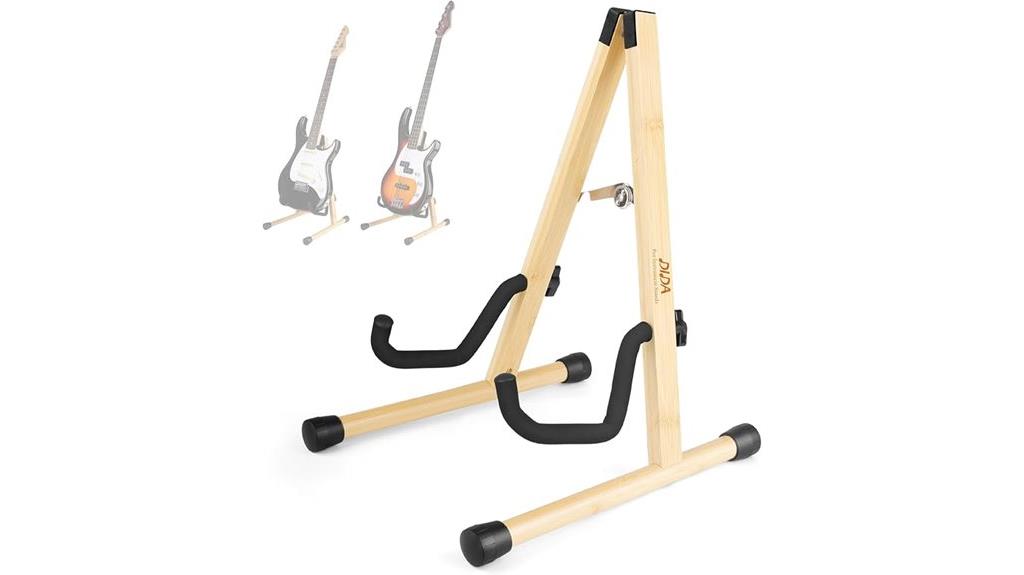
The DIDA Electric Guitar Stand represents a compelling intersection of traditional woodworking craftsmanship and modern instrument protection, making it an exceptional choice for musicians who value both aesthetic appeal and functional reliability in their gear setup. You’ll appreciate the solid natural wood construction available in five distinct materials, from bamboo to American Black Walnut, each featuring unique grain patterns that complement your instrument’s finish. The 3mm soft foam padding at contact points prevents scratches, while 304 stainless steel hardware guarantees long-term durability. Assembly takes just five minutes, and the collapsible design makes transport convenient for gigs. With a 4.7-star rating, it’s proven reliable.
Best For: Musicians who want an aesthetically pleasing, portable guitar stand that combines traditional woodworking craftsmanship with reliable instrument protection for home use, studio sessions, and live performances.
Pros:
- Available in five beautiful wood options with unique grain patterns that complement instrument finishes
- Quick 5-minute assembly with collapsible design for easy transport and storage
- Solid construction with 3mm foam padding and stainless steel hardware for durability and scratch prevention
Cons:
- Lacks neck support which some users prefer for additional security
- Requires careful placement to avoid potential scrapes if guitar is placed hastily
- May not provide the same level of security as stands with neck/headstock support
Amazon Basics Height Adjustable Foldable Guitar Stand
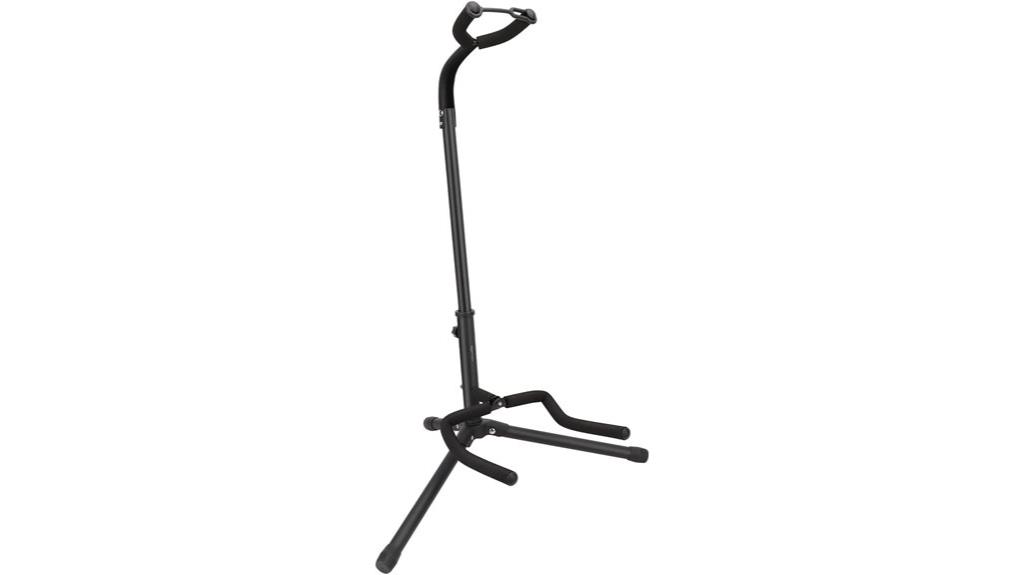
Budget-conscious musicians who need reliable instrument storage will find Amazon’s Height Adjustable Foldable Guitar Stand delivers impressive versatility, accommodating acoustic guitars, electric guitars, bass guitars, and even 26-inch ukuleles through its thoughtfully engineered design. The durable iron frame construction features soft rubber padding at essential contact points, while the sturdy tripod base incorporates thick metal support bars and anti-slip rubber feet that provide excellent stability during use. You’ll appreciate the self-centering lower yoke and rubber end caps that prevent your instruments from sliding or tipping, plus the secure height-adjustable mechanism with friction knob effectively locks to prevent unwanted upper yoke rotation.
Best For: Budget-conscious musicians who need a versatile and portable stand for acoustic guitars, electric guitars, bass guitars, or 26-inch ukuleles.
Pros:
- Versatile compatibility with multiple instrument types including acoustic, electric, bass guitars and 26-inch ukuleles
- Durable iron frame construction with soft rubber padding and anti-slip rubber feet for excellent stability
- Folds flat for easy storage and transport, making it ideal for traveling musicians
Cons:
- Not suitable for jazz bass or jazz guitar instruments
- Basic design may lack premium features found in higher-end stands
- Friction knob locking mechanism may require periodic adjustment over time
GLEAM Adjustable Guitar Stand for Electric, Classical Guitars and Bass (CG-4)
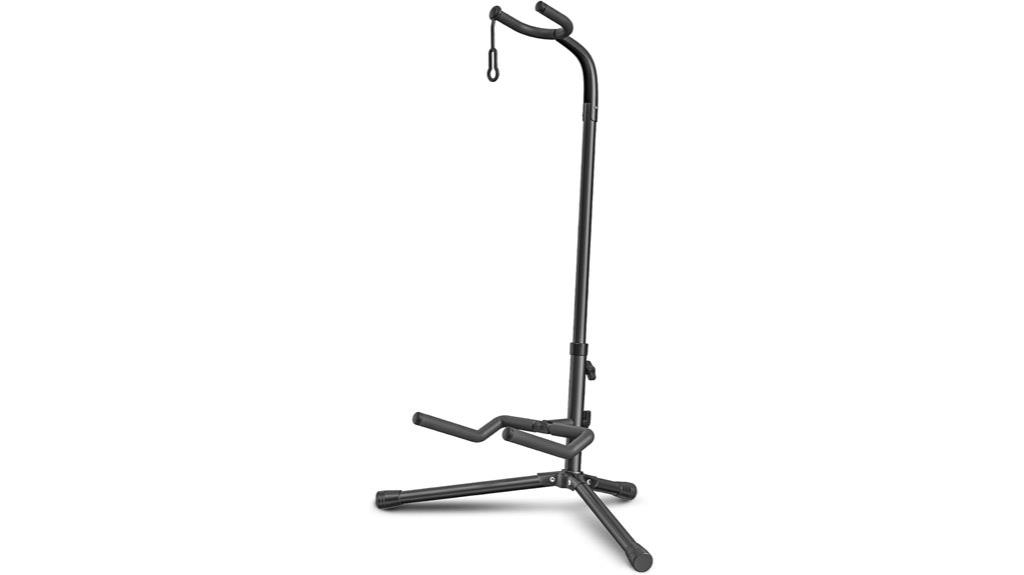
Musicians seeking a versatile, budget-friendly stand that accommodates multiple instrument types will find the GLEAM CG-4 particularly appealing, as it’s engineered to securely hold electric guitars, classical guitars, and bass guitars with its adjustable height mechanism ranging from 25.6 to 28.4 inches. The traditional folding design features foam-padded arms and a soft backrest that’ll protect your instrument’s finish, while the non-slip feet provide stable placement on various surfaces. At just 1.63 pounds with a 20-pound load capacity, it’s lightweight enough for easy transport yet sturdy enough for most instruments, though you’ll want something heavier for permanent storage situations.
Best For: Musicians who need a portable, budget-friendly stand for multiple instrument types including electric, classical, and bass guitars for temporary use, practice sessions, or transportation between venues.
Pros:
- Adjustable height (25.6-28.4 inches) with foam-padded arms and soft backrest to protect instrument finishes from scratches
- Lightweight at 1.63 pounds yet supports up to 20 pounds, making it highly portable while accommodating various guitar types including odd-shaped instruments
- Foldable design with non-slip feet offers convenient storage and transport with stable placement on different surfaces
Cons:
- Center of gravity issues and lack of locking mechanism on bottom arms can cause stability problems, especially around children and pets
- Lightweight construction makes it prone to tipping if bumped, requiring careful placement in high-traffic areas
- Better suited for temporary use rather than permanent storage, as durability concerns with rubber components may affect long-term reliability
Amazon Basics Adjustable Folding Guitar Stand, A-shape, Black
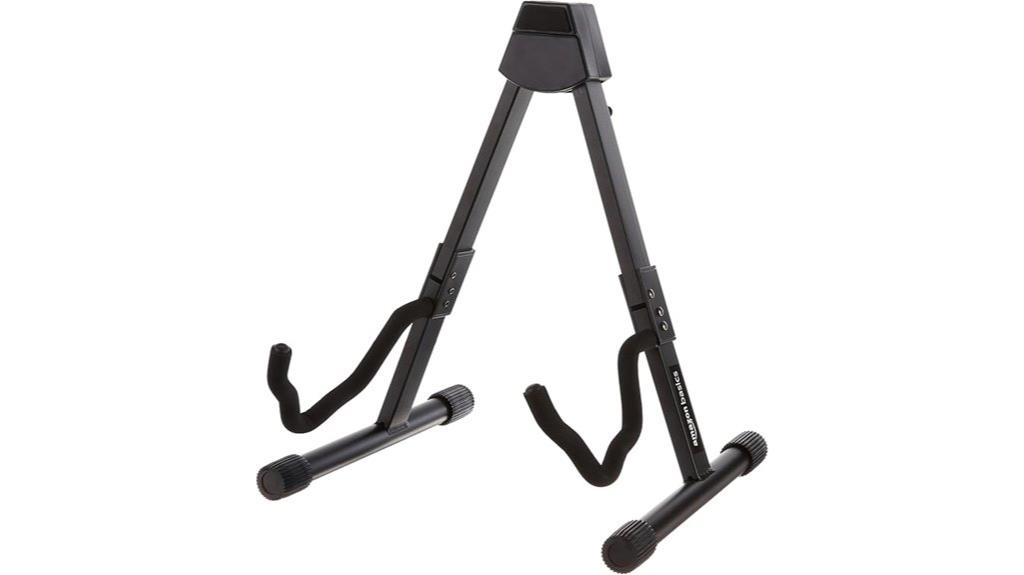
Amazon’s entry-level guitar stand delivers exceptional value for music educators, students, and casual players who need reliable instrument support without breaking the bank. The A-frame design accommodates both acoustic and electric guitars through three adjustable-width settings, making it particularly suitable for shared environments like classrooms and performance venues where multiple instruments require secure positioning. Its lightweight metal construction arrives fully assembled, eliminating setup frustration while maintaining durability for regular use. Soft foam padding protects your instrument’s finish across contact points, while non-slip rubber feet prevent sliding on stage floors, and the flat-folding design simplifies transport between gigs.
Best For: Music educators, students, and casual players who need an affordable, reliable guitar stand for shared environments like classrooms and performance venues.
Pros:
- Three adjustable-width settings accommodate various guitar shapes and sizes
- Lightweight metal construction with soft foam padding protects instrument finish
- Folds flat for easy transport and storage, perfect for gigs and classroom use
Cons:
- Basic entry-level design may lack premium features found in higher-end stands
- Metal construction might not be as stable as heavier, more robust stands
- Limited to A-frame design which may not suit all guitar types or user preferences
CAHAYA Folding Universal Guitar Stand with Adjustable Height
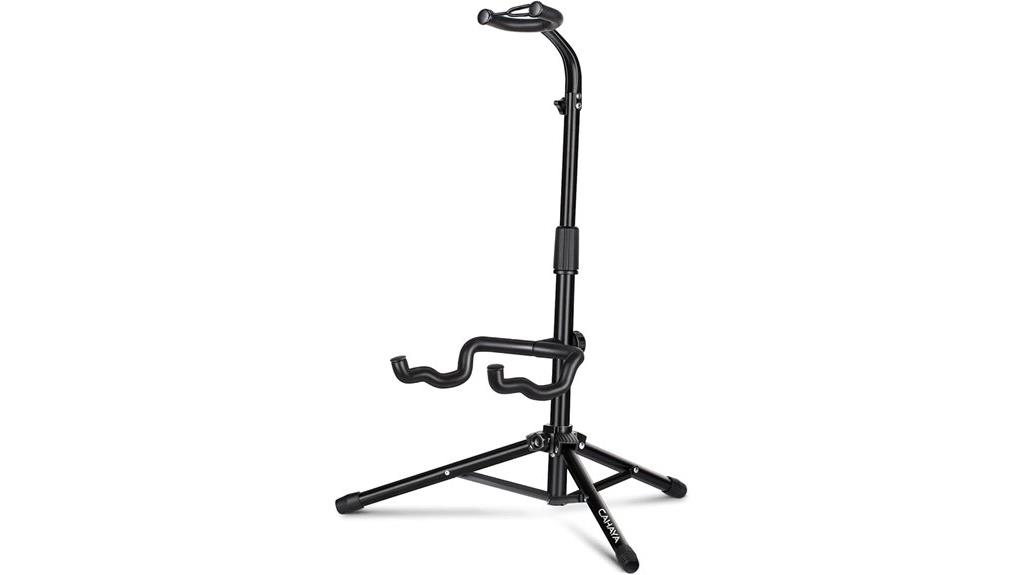
The CAHAYA Folding Universal Guitar Stand’s adjustable height mechanism, ranging from 30.7 to 37 inches, makes it an ideal choice for bassists who need accommodating taller instruments while maintaining rock-solid stability. What sets this stand apart is its umbrella-shaped structure with three thick metal support bars, which creates a sturdy foundation that won’t tip under your bass’s weight. The reinforced cradle-bracket connection, improved through customer feedback, secures both thin and thick instruments with thick sponge padding protecting your finish. You’ll appreciate its tool-free assembly and space-saving folding design for gigs.
Best For: Bassists and guitarists who need a stable, adjustable stand that can accommodate both thin and thick instruments while offering easy portability for gigs and practice sessions.
Pros:
- Umbrella-shaped structure with three thick metal support bars provides exceptional stability for heavy bass guitars and prevents tipping
- Adjustable height range of 30.7 to 37 inches with reinforced cradle-bracket connection accommodates various instrument sizes securely
- Tool-free assembly and space-saving folding design makes it highly portable for transportation to concerts and festivals
Cons:
- Excessive height may make the stand unsteady in certain situations despite overall stable design
- Risk of losing screws during disassembly requires careful handling and storage of components
- Some users report concerns about stability at maximum height settings when used with very heavy instruments
GUITTO Guitar Stand Tripod A-Frame for Acoustic and Electric Guitars (GGS-01)

Portability stands as the defining strength of GUITTO’s GGS-01 tripod stand, making it an exceptional choice for gigging musicians who need reliable instrument support without the bulk of traditional stands. Weighing just 15.9 ounces, this foldable A-frame design collapses into guitar cases effortlessly, eliminating the hassle of carrying separate stand equipment to venues. You’ll appreciate its adjustable arms that accommodate acoustic guitars, electric guitars, and bass instruments with equal confidence, while thick rubber padding protects your finish from scratches during performance breaks. The secure lock system and non-slip feet provide surprising stability for such a lightweight construction, though I’d recommend treating it as your portable solution rather than your primary home studio stand.
Best For: Gigging musicians and traveling performers who need a lightweight, portable guitar stand that can easily fit in cases while providing reliable temporary instrument support.
Pros:
- Exceptional portability at just 15.9 ounces with foldable design that fits in guitar cases and gig bags
- Universal compatibility with acoustic guitars, electric guitars, bass instruments, and ukuleles through adjustable arms
- Protective features including thick rubber padding and non-slip feet that prevent scratches and ensure stability
Cons:
- Not recommended for heavy-duty or permanent use, better suited for temporary setups
- Rubber padding may wear down over time with frequent use
- Lightweight construction may not provide the same stability as heavier, more robust stands
DkOvn A-Frame Folding Guitar Stand (1/2/4 Pack)
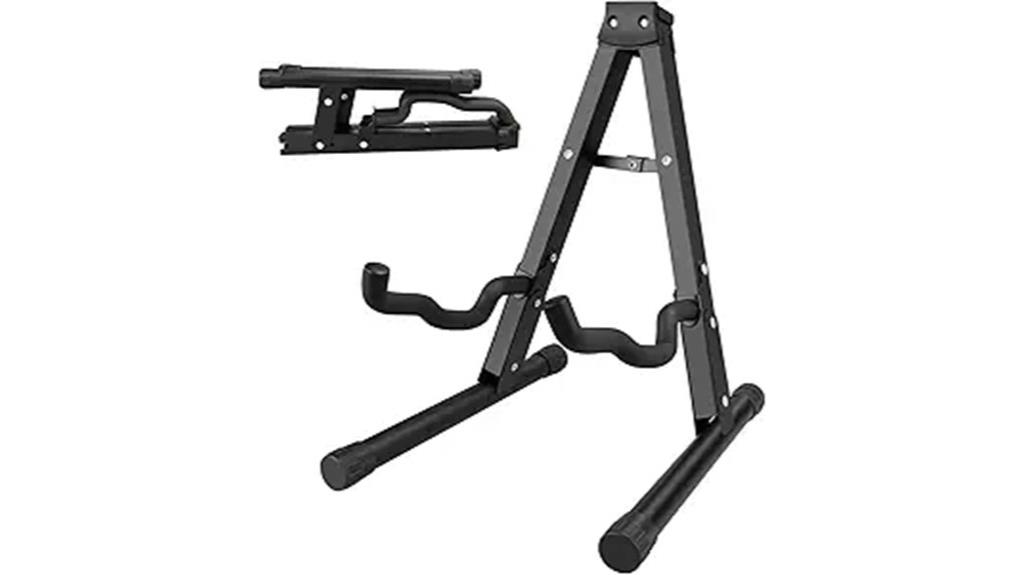
Musicians who frequently travel between gigs, practice sessions, and recording studios will find the DkOvn A-Frame Folding Guitar Stand particularly appealing, as its compact folding design transforms from a stable instrument holder into a flat profile that measures just 14.6 x 2.6 x 5.3 inches for effortless transport. You’ll appreciate the soft EVA foam padding that protects your bass from scratches, while the non-slip silicone feet prevent unwanted movement during performances. With a 15.5-pound load capacity, this stand accommodates most electric basses comfortably, though I’d exercise caution with particularly heavy instruments in high-traffic areas.
Best For: Musicians who need a portable, versatile stand for acoustic guitars, electric guitars, bass guitars, ukuleles, and other stringed instruments up to 15.5 pounds, especially those who travel frequently between practice sessions, gigs, and recording studios.
Pros:
- Compact folding design makes it extremely portable and easy to store, with no assembly required
- Soft EVA foam padding and non-slip silicone feet provide excellent instrument protection and stability
- Versatile compatibility with multiple instrument types including guitars, bass, ukulele, banjo, violin, and cello
Cons:
- 15.5-pound weight limit may not accommodate some heavier bass guitars or instruments
- May lack stability with heavier instruments in high-traffic or busy performance environments
- A-frame design offers less adjustability compared to tripod-style stands for different instrument sizes
Factors to Consider When Choosing a Bass Guitar Stand
I’ve tested dozens of bass guitar stands over the years, and I can tell you that choosing the right one isn’t as straightforward as grabbing the cheapest option at the music store. When I’m evaluating stands for my bass collection, I focus on five critical factors that determine whether a stand will protect your instrument reliably, perform consistently during gigs and practice sessions, and provide long-term value for your investment. These considerations—weight capacity limits, stability features, portability options, construction quality, and protective padding—will guide you toward a stand that matches your specific playing style, budget constraints, and performance requirements.
Weight Capacity Limits
When you’re shopping for a bass guitar stand, the weight capacity becomes your most critical specification to verify, since most bass guitars weigh between 7 to 11 pounds, and you’ll need a stand that can handle considerably more than that baseline. I always recommend selecting stands with at least 15% additional capacity beyond your instrument’s weight, which provides the stability margin that prevents those heart-stopping moments when your bass wobbles unexpectedly. Heavy-duty metal construction consistently outperforms lightweight plastic alternatives, especially when you’re dealing with vintage or custom models that exceed standard weight ranges. While adjustable width features offer versatility, I’ve noticed they can affect weight distribution, so verify that any adjustments don’t compromise the stand’s overall load-bearing integrity for your specific instrument.
Stand Stability Features
Weight capacity alone doesn’t guarantee your bass will stay upright, since I’ve learned that stability features ultimately determine whether your instrument remains secure or becomes an expensive floor decoration. I prioritize stands with sturdy bases featuring anti-slip rubber feet, which prevent sliding on hardwood floors and concrete stages alike. Adjustable height mechanisms with secure locking arms accommodate my different bass shapes while maintaining unwavering grip strength throughout performances. A-frame and tripod designs distribute weight evenly, reducing tipover risk that I’ve witnessed destroy instruments during rushed stage setups. Most importantly, I insist on protective padding at all contact points, which not only safeguards my bass’s finish but creates friction that prevents unexpected shifts when someone inevitably bumps into my setup.
Folding and Portability
Since I’ve hauled bass gear through countless subway stations, airport terminals, and cramped venue backstages, I can’t overstate how folding stands have revolutionized my mobile setup routine. These ingenious designs collapse completely flat, sliding effortlessly into most gig bags alongside cables and effects pedals without adding bulk or weight penalties.
I’ve noticed aluminum and high-strength plastic models offer the best portability-to-durability ratio, maintaining structural integrity despite repeated folding cycles. The adjustable height settings accommodate everything from short-scale basses to extended-range instruments, while secure locking mechanisms prevent accidental collapse during performance.
What sold me completely was discovering stands with non-slip rubber feet that maintain stability on stages ranging from carpeted coffee shops to polished theater floors, proving that portability doesn’t require sacrificing security.
Material Construction Quality
The backbone of any reliable bass stand lies in its material construction, where the difference between a $20 plastic frame and a $60 metal alternative becomes painfully obvious after your first unexpected tumble. I’ve learned that high-strength engineering plastic paired with metal joints, especially those sporting powder-coated finishes, delivers impressive longevity while resisting daily wear and tear. Heavy-duty solid wood bases or alloy steel frames provide superior stability across various surfaces, which becomes essential when you’re supporting a hefty five-string bass. What I particularly appreciate is soft foam padding at every contact point – thicker pads mean better protection against scratches and enhanced stability. Quality construction also translates to easier assembly and more compact storage without sacrificing structural integrity.
Protection and Padding
After dropping my beloved Fender Jazz Bass twice from poorly padded stands, I can’t stress enough how essential proper protection becomes when you’re investing serious money in quality instruments. I’ve learned that soft foam padding at contact points prevents those heartbreaking scratches and finish damage that’ll haunt you forever. The best stands feature thick EVA foam pads on their arms, which absorb impacts and protect delicate components during those inevitable bumps. I always check for protective rubber feet that enhance stability and grip, reducing tipping risks remarkably. Secure locking mechanisms keep your bass firmly positioned, while cradles designed to match your instrument’s contours eliminate pressure points that could cause structural damage over time.
Height Adjustment Options
Beyond guaranteeing your bass stays scratch-free, finding the right height adjustment range becomes equally important for both comfort and functionality. I’ve found that most quality stands offer height ranges from 25 to 37 inches, which accommodates different bass sizes and player heights effectively. The locking mechanism becomes essential here, as I’ve learned from experience that stands without secure locks can shift unexpectedly during performances or practice sessions. When evaluating stands, I look for screw mechanisms at the top yoke, which prevent unwanted rotation and bending that could compromise instrument security. Additionally, I appreciate designs with padded arms that adjust to various bass shapes, since this dual adaptability guarantees both proper height customization and reliable instrument support across different venues.
Bass Guitar Compatibility
Compatibility issues can make or break your stand selection, and I’ve discovered that not all stands work equally well with every bass guitar design. Universal compatibility becomes essential when you’re dealing with different body shapes, from sleek jazz basses to bulky hollow-body models, because each requires specific dimensional considerations that standard guitar stands simply can’t accommodate.
I always look for stands explicitly labeled for bass guitars, since they’re engineered with the proper weight capacity and sizing to handle these larger instruments. The body width, neck length, and overall weight distribution of bass guitars demand specialized cradle designs that won’t stress the instrument’s finish or structural integrity, making generic stands a risky proposition for serious players.
Assembly Requirements
Three distinct assembly categories define most bass guitar stands on the market today, and I’ve found that understanding these differences can save you significant frustration when you’re setting up for practice sessions or performances. Ready-to-use models arrive fully assembled, letting you unpack and immediately position your instrument without wrestling with instructions or hardware. Simple assembly stands require connecting two or three components using basic tools, typically taking just minutes to complete. Adjustable models demand more attention during setup, particularly when configuring height settings and engaging locking mechanisms that guarantee stability. Portable designs shine with their foldable construction, eliminating complex assembly while maximizing transport convenience. I always check assembly requirements before purchasing, since setup time directly impacts usability.
On a final note
I’ve tested countless bass stands throughout my playing career, and these options represent the most reliable choices for protecting your investment. Whether you’re seeking basic portability with the Amazon Basics models or premium stability with the wooden DIDA stand, each option delivers proven performance. Remember, a quality stand isn’t just about convenience—it’s about preventing costly damage from falls and maintaining your bass’s structural integrity over time.

